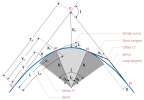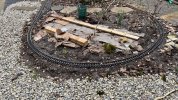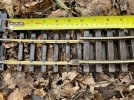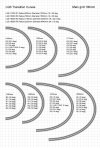mikeabdullah
Registered
Hi there, newcomer to G scale here. Currently experimenting with track layout in my garden for myself and 5 year old son to enjoy mucking about with.
While doing this, I find myself bumping into an area that I thought would be common, but which I struggle to find basically any results for on the Internet. Typical!
I'm aiming for a minimum of LGB radius 3 curves on vast majority of the track, to keep it looking decent and not too tight, and I'm very pleased with the results so far. The spots where I do have R1 points or R2 curves certainly do become sticky running spots quite easily.
I've also got quite a large number of LGB radius 5 curves (18000, 15º) bought for nice gradual curves wherever the space allows it.
To my eye, on the tighter R3 bends, it looks really good to use a short section of R5 as a transition. Supposedly this makes it a little easier for the train to navigate (I'm not sure), and it certainly looks smoother!
Is anyone else out there doing this? I seem to find almost no discussion of transition curves for G scale, particularly specially the use of R5 for the purpose. Maybe all the serious folk go straight to flexitrack for this?
I had initially purchased a couple of these, but I soon wanted more. Then I stared a little closer at all the 15º r5 pieces I've got. They've got a fishplate in the middle of the curve! As best I can tell, the r5 curves are constructed out of 2x 7.5º sections of sleepers, with 15º rails threaded through.
It took some effort, but today I was able to dismantle one, cut the rail in half, and tada I've now got two 7.5º r5 curves, exactly as I wanted, for "free" from leftover full length curves. Very pleased with the result.
Is this a deliberate thing from LGB?? Does anyone else do this? Even more so than the transition curves, I seem unable to find any mention of this on the internet.
While doing this, I find myself bumping into an area that I thought would be common, but which I struggle to find basically any results for on the Internet. Typical!
I'm aiming for a minimum of LGB radius 3 curves on vast majority of the track, to keep it looking decent and not too tight, and I'm very pleased with the results so far. The spots where I do have R1 points or R2 curves certainly do become sticky running spots quite easily.
I've also got quite a large number of LGB radius 5 curves (18000, 15º) bought for nice gradual curves wherever the space allows it.
To my eye, on the tighter R3 bends, it looks really good to use a short section of R5 as a transition. Supposedly this makes it a little easier for the train to navigate (I'm not sure), and it certainly looks smoother!
Is anyone else out there doing this? I seem to find almost no discussion of transition curves for G scale, particularly specially the use of R5 for the purpose. Maybe all the serious folk go straight to flexitrack for this?
Choppity Chop
For a transition curve, I particularly like the look of an LGB half R5 piece, 7.5º, product code 18020.I had initially purchased a couple of these, but I soon wanted more. Then I stared a little closer at all the 15º r5 pieces I've got. They've got a fishplate in the middle of the curve! As best I can tell, the r5 curves are constructed out of 2x 7.5º sections of sleepers, with 15º rails threaded through.
It took some effort, but today I was able to dismantle one, cut the rail in half, and tada I've now got two 7.5º r5 curves, exactly as I wanted, for "free" from leftover full length curves. Very pleased with the result.
Is this a deliberate thing from LGB?? Does anyone else do this? Even more so than the transition curves, I seem unable to find any mention of this on the internet.




